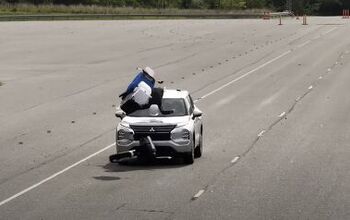NHTSA Opens Investigation Into Hyundai's Theta II Engine Debris Recalls

The timeliness of a recall of Hyundai and Kia vehicles equipped with Theta II four-cylinder engines is the focus of a formal National Highway Traffic Safety Administration investigation revealed today.
Metal engine debris resulting from a faulty production process is behind the expansive recall of nearly 1.7 million vehicles, but the NHTSA wants to know if the recall expanded too slowly. Just how much Hyundai knew about the widespread issue is a big question mark, made all the more pressing by the testimony of a company whistleblower.
According to Reuters, filings published today show the NHTSA opened an investigation on May 18th into “both the timeliness and scope” of the recalls, as well as Hyundai’s “compliance with reporting requirements.”
The automaker has stated it will cooperate with the investigation.
The issue facing older 2.4-liter and turbocharged 2.0-liter Theta II powerplants involves metal shavings surrounding the crankshaft of the engines. That debris can contaminate the engine oil, leading to restricted oil circulation, component wear, and the potential for engine failure.
While the recalls eventually covered numerous Hyundai and Kia vehicles in the U.S., Canada and South Korea, the company appears to have been slow to address the problem. The first recall, in 2015, involved just 470,000 Sonata sedans sold in the U.S., despite the exact same engine appearing in other models. Earlier this year, the company recalled a slew of 2013 and 2014 Sonata and Santa Fe vehicles, while Kia called back over half a million 2011-2014 model year Optima, Sorento and Sportage models to address the engine debris problem.
A former longtime Hyundai engineer, Kim Gwang-ho, has loomed over the issue since the recalls began. Last August, Kim delivered a stack of internal documents to the NHTSA, explaining his concerns that the problem was far more widespread than the automaker let on. The engineer claims to have attended a July 2015 meeting in Seoul where colleagues discussed downplaying the problem to avoid a huge repair bill.
The latest recall has cost the company $322 million.
[Image: Hyundai]

More by Steph Willems
Latest Car Reviews
Read moreLatest Product Reviews
Read moreRecent Comments
- Zipper69 "At least Lincoln finally learned to do a better job of not appearing to have raided the Ford parts bin"But they differentiate by being bland and unadventurous and lacking a clear brand image.
- Zipper69 "The worry is that vehicles could collect and share Americans' data with the Chinese government"Presumably, via your cellphone connection? Does the average Joe in the gig economy really have "data" that will change the balance of power?
- Zipper69 Honda seem to have a comprehensive range of sedans that sell well.
- Oberkanone How long do I have to stay in this job before I get a golden parachute?I'd lower the price of the V-Series models. Improve the quality of interiors across the entire line. I'd add a sedan larger then CT5. I'd require a financial review of Celestiq. If it's not a profit center it's gone. Styling updates in the vision of the XLR to existing models. 2+2 sports coupe woutd be added. Performance in the class of AMG GT and Porsche 911 at a price just under $100k. EV models would NOT be subsidized by ICE revenue.
- NJRide Let Cadillac be Cadillac, but in the context of 2024. As a new XT5 owner (the Emerald Green got me to buy an old design) I would have happy preferred a Lyriq hybrid. Some who really like the Lyriq's package but don't want an EV will buy another model. Most will go elsewhere. I love the V6 and good but easy to use infotainment. But I know my next car will probably be more electrified w more tech.I don't think anyone is confusing my car for a Blazer but i agree the XT6 is too derivative. Frankly the Enclave looks more prestigious. The Escalade still has got it, though I would love to see the ESV make a comeback. I still think GM missed the boat by not making a Colorado based mini-Blazer and Escalade. I don't get the 2 sedans. I feel a slightly larger and more distinctly Cadillac sedan would sell better. They also need to advertise beyond the Lyriq. I don't feel other luxury players are exactly hitting it out of the park right now so a strengthened Cadillac could regain share.


































Comments
Join the conversation
We once owned a Hyundai Veracruz (3.8 V6) which produced a toenail-clipping-sized metal spiral at the first oil drain; clearly leftover debris from the manufacturing process. In theory this sort of thing is "normal", and one of the reasons to do your first oil change promptly. Still, it's not very confidence-inspiring.
Funny, when they came out with their big warranty, everyone started preaching how reliable their new cars were. Not only is their warranty itself unreliable, but as I always said, you can't call a car reliable until they're 5-10 years old and the data is in.